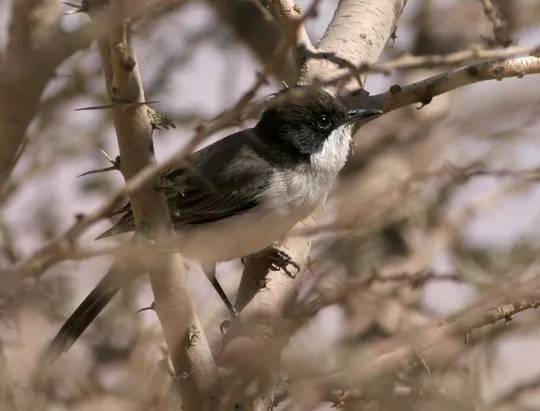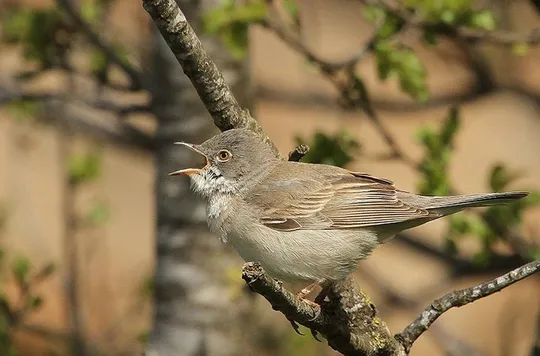Sylvia conspicillata
 Vulnerable
Vulnerable
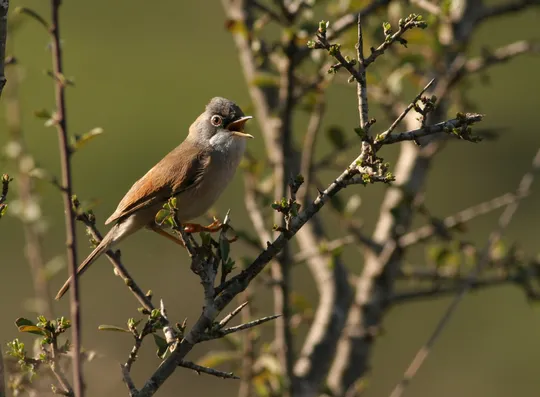
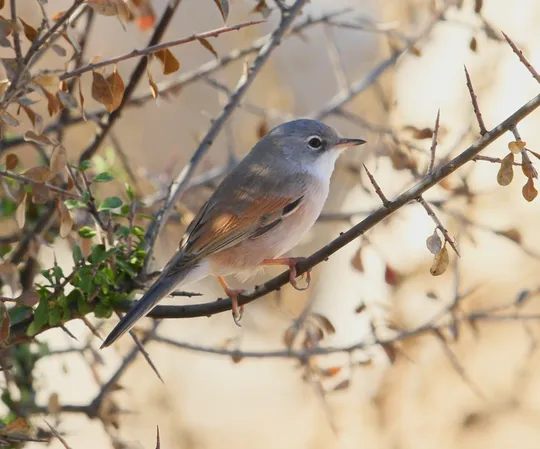

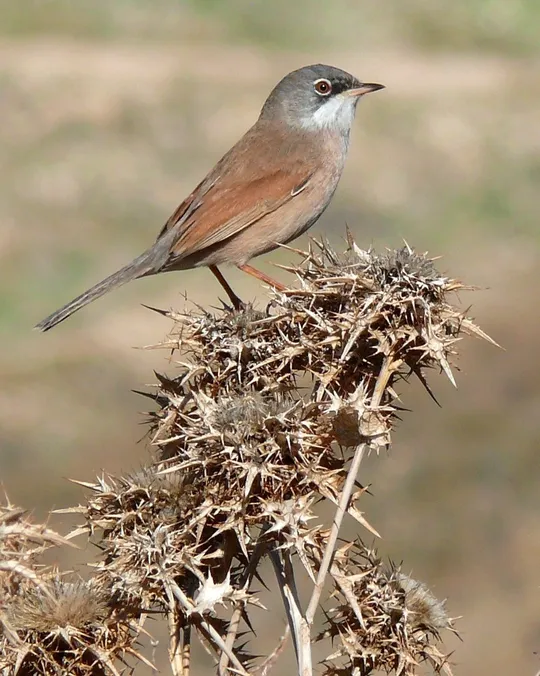
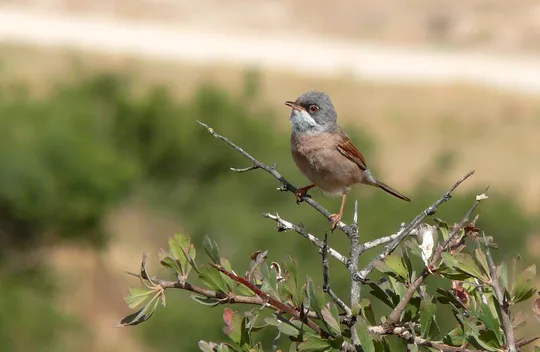
| Habitats | Mediterranean Batha, Semi-desert Batha |
|---|---|
| Presence In Israel | Resident |
| Breeding In Israel | Breeder |
| Migration Types | Short Range / Partial |
| Zoographical Zones | Irano-Turanian |
| Landscape Types | Mountainous, Wide Wadis |
| Vegetation Types | Steppe |
| Vegetation Densities | Low |
| Nest Locations | Bushes |
| Diet Types | Invertebrate |
| Foraging Grounds | Trees and Shrubs |
| Body Sizes | Small (up to 500g) |
| Threat Factors | Wildfires, Overgrazing, Habitat loss and fragmentation, Tree planting |
The Spectacled Warbler is a small, shy warbler that inhabits shrubland in the desert and semi-arid transition areas. The male is relatively colorful for a warbler, with a bluish-grey head and a prominent white eye-ring. Underparts are pale pink and flight feathers rufous. The female and juveniles have a grey head and white underparts and a chestnut wing patch. The Spectacled Warbler has a narrow slender body with a long tail and short, rounded wings. In the field, it jumps nimbly from shrub to shrub, raising its tail occasionally. Its call is a raspy warble that usually reveals its presence.
A resident species found in shrubland in desert and steppe regions, with a patchy distribution – very common in some areas and completely absent from others. Outside the breeding season, it moves to lower regions, particularly the Arava and Jordan valleys. On Mt. Hermon, the Spectacled Warbler is found in the spiny-cushion-plants (tragacanth) zone up to altitudes of 2,100 meters. In Judea and Samaria, it is restricted to well developed, dense Prickly Burnet Sarcopoterium spinosum scrub patches, mainly on the eastern side of Israel’s watershed. In the Negev, it breeds sparsely, mainly in the Yeroham-Dimona and Revivim-Nitsana areas, and in the Western Negev sands. In the early 20th century, the Spectacled Warbler population apparently expanded north and west to areas of Prickly Burnet scrubland formed after native woodland was cut. In the 1970s, this expansion stopped and the population began receding because of reduced grazing, development and afforestation. During the 1980s and 1990s, the species gradually disappeared from extensive areas of Judea and Samaria, from Mt. Carmel, the Eastern Galilee and the southern Golan Heights.
Open exposed landscapes with low vegetation, mainly in the desert and steppe regions. In the Mediterranean region, it is associated with the Prickly Burnet plant community, in the desert region it nests in wadis with patches of shrubs and grasses.
Habitat modification, particularly due to development, planting and expansion of agricultural areas. Overgrazing causes a direct disturbance, nest trampling and nestling predation (by dogs accompanying the herds). This is a major factor in the semi-arid transition area in Judea, Samaria and the Northern Negev, while lack of grazing in the Carmel and Galilee led to alteration and shrinking of suitable habitats for the warblers.
No specific conservation measures have been taken for this species to date.
- ישראלי, נ. ופרלמן, י. 2013. סיכום סקר עופות מקננים בחרמון. דו"ח מרכז הצפרות של החברה להגנת הטבע.
- מירוז, א. 2013. סיכום סקר ציפורים במזרח לכיש, אביב 2013. דו"ח רשות הטבע והגנים.
- מירוז, א. ושוחט, א. 2014. סיכום סקר ציפורים סביב היישוב נטע במזרח לכיש – 2014. דו"ח רשות הטבע והגנים.
- מירוז, א., 2007 . סיכום סקר ציפורים בגבעות גומר. דו"ח עבור רשות הטבע והגנים.
- פז, ע. 1986. עופות. מתוך אלון, ע. (עורך), החי והצומח של ארץ ישראל. כרך 6. הוצאת משרד הביטחון, ישראל.
- Perlman, Y., Shochat, E. and Labinger, Z. 2011. Developing Managment plan for important bird areas in southern Israel. second annual report, Nizzana region and Arava Valley.Israeli Ornithological center, SPNI.
- Shirihai, H., 1996. The Birds of Israel. Academic Press, London.
- Shochat, E., Abramski, Z., Pinshow, B., 2001. Breeding bird species diversity in the Negev: Effects of Scrub Fragmentation by planted forests. Journal of Applied Ecology, 38, 1135-1147.
- Symes, A. 2013. Species generation lengths. Unpublished, BirdLife International.
- Species page at Birdlife International
Current Occupancy Map
| Data Missing | Sporadic | Limited Sites | Low Density | High Density |
|---|---|---|---|---|
| 0 | 0 | 0 | 0 | 0 |
Distribution maps
The maps presented here provide visual information on the distribution of species in Israel from the past and present, and the changes in occupancy and breeding density during the comparison period. For further reading
Relative Abundance 2010-2020
Breeding density values in the current decade as determined from experts' opinion and observations from databases.
| Data Missing | Sporadic | Limited Sites | Low Density | High Density |
|---|---|---|---|---|
| 8 | 12 | 12 | 21 | 19 |
Relative Abundance 1980-1990
Density values based primarily on the book The Birds of Israel (Shirihai 1996).
| Data Missing | Sporadic | Limited Sites | Low Density | High Density |
|---|---|---|---|---|
| 5 | 14 | 14 | 17 | 22 |
Occupancy 1990-2020
The map shows differences in the species breeding distribution between the 1980's breeding map and the current weighted breeding evaluation. Negative value - species previously bred in the grid and is not presently breeding; positive value - species has not previously bred in the grid and is currently breeding.
| Data Missing | No Change | Occupancy Increase | Occupancy Decrease |
|---|---|---|---|
| 6 | 35 | 1 | 9 |
Change in Relative Abundance 1990-2020
The map shows the changes in the relative abundance of a species in each of the distribution grids between the breeding map of the 1980s and the weighted current breeding evaluation. Negative values - decline in abundance; positive values - increase in abundance; zero - no change in abundance.
| 80 to 100 | 50 | 20 to 30 | No Change | 30- to 20- | 50- | 100- to 80- | Data Missing |
|---|---|---|---|---|---|---|---|
| 0 | 4 | 2 | 22 | 12 | 14 | 11 | 16 |
| Rarity | |
|---|---|
| Vulnerability | |
| Attractiveness | |
| Endemism | |
| Red number | |
| Peripherality | |
| IUCN category | |
| Threat Definition according to the red book |
 Contributed:
Contributed: 